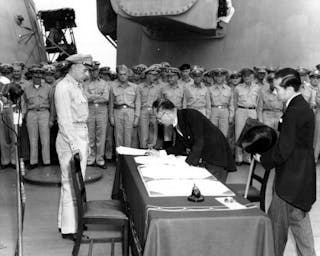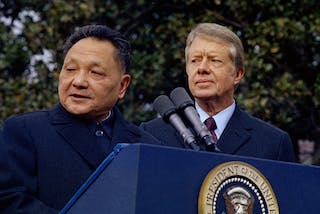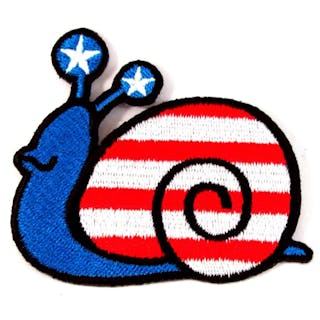What you need to know
Legally, Taiwan is a piece of territory that was "never returned" properly. What roles have Japan and the United States played historically?
Taiwan holds a unique position in the realm of international law. Domestically, Taiwan possesses all the qualities of a “normal country,” including citizenship, territorial jurisdiction, government, and “sovereignty.” Taiwan is sovereign by the international law definition — it’s an ultimate authority independent of other authorities in the world; however, Taiwan does not have a common recognition internationally.
According to Oppenheim’s International Law: A Treatise, recognition is a requirement for a country to become a member of the international family, and having the qualifications alone are not enough. By this definition, Taiwan is not a “normal” country like the majority of the existing nations.
But compared to other “non-normal” countries, Taiwan is incredibly close to being a regular country and with far more capabilities.
After the Soviet Union collapsed, four countries — South Ossetia, Abkhazia, Transnistria, and Artsakh — claimed independence and recognized one another’s sovereignty. These countries, however, barely have any diplomatic partners (Taiwan has at least maintained 15 allies to date). The passports issued by these four countries are also not recognized in most of the world, and their citizens mostly have dual-citizenship that granted them a valid passport from another country. Taiwan, in comparison, offers a passport that has visa-free access to over 150 countries.
Other “standard” countries wish to make their territories independent, but ironically Taiwan is the opposite. The official name for Taiwan is the Republic of China (ROC); even though many Taiwanese now think of Taiwan as a country independent of the People’s Republic of China (PRC), the meaning of “independence” is still much debated domestically.
According to the current Constitution, the definition of ROC territories still includes mainland China. From the international law standpoint, Taiwan and Beijing are still maintaining the relationship of “one country, two governments.” James Crawford, the author of The Creation of States in International Law, also denied Taiwan as an independent country in his book as Taiwan has never explicitly claimed independence.
In terms of succession of states, the ROC is the legal inheritor of the Qing Dynasty. Before 1949, although the ROC was split into two phases — the Beiyang government and the Kuomintang (KMT) — the transfer of government from Beiyang to the KMT was recognized internationally. Therefore, the KMT-ruled ROC had the legal right to inherit the Qing dynasty’s properties. But after the Chinese Civil War, the Communist Party has been seen as the sole representative of China, also the legitimate inheritor of what the ROC government left behind.
Yet Taiwan’s unique international status is not only due to using a “shared domain” with China, but it is also a problem unresolved after the war. Japan, the United States, and the United Nations have all contributed to Taiwan’s status today.
Japan was responsible for surrendering Taiwan in 1951, but did not specify which country Taiwan was “returned” to. The U.S. has the most influence on Taiwan and its attitude toward Taiwan is key to preserving the island’s democracy. Meanwhile, the U.N. has become the unit of approval for any country that wishes to join the “international family” club.

Japan never admitted that “Taiwan was returned to China.”
Taiwan was already ceded to Japan before the end of the Qing dynasty. From China’s perspective, it was an “unequal treaty.” However, in terms of international law, it was a legal transfer of territory. At the same time, recognizing the legality of territorial transfer doesn’t erase the possibility of returning such territory legally again.
In the case of Hong Kong, for example, Kowloon and Hong Kong island were both ceded to Britain in perpetuity. Yet the Sino-British Joint Declaration stated that the PRC would legally repossess the entire Hong Kong.
After the Second World War, Taiwan should have been returned to the ROC as well. Practically speaking, the ROC has indeed reclaimed Taiwan. But in terms of international law, whether Taiwan has been returned remains in an “incomplete” status.
Three documents — the Cairo Declaration, the Potsdam Declaration, and the Japanese Instrument of Surrender — have determined that Taiwan must be returned to China after WWII. However, each of these documents standing alone is insufficient to prove that Taiwan must be returned. We have to examine all three together to clarify the logic.
The Cairo Declaration was the only document that mentioned: “all the territories Japan has stolen from the Chinese, such as Manchuria, Formosa, and The Pescadores, shall be restored to the Republic of China.” But it was not signed by Japan — it was more like a statement of political will. The 1945 Potsdam Declaration was signed between the Allies, and it stated that Japan must accept the Cairo Declaration, but again it was not a treaty signed off by Japan.
The 1945 Japanese Instrument of Surrender was signed between Japan’s representatives and the Allies, officially the end of the war. Ironically, this treaty did not mention the Cairo Declaration or Taiwan. It had only stated Japan’s acceptance of the conditions outlined in the Potsdam Declaration, indirectly linking it to the initial Cairo Declaration.
Despite all the twists and turns, Taiwan was “supposed” to be returned to the ROC.
Legally speaking, however, the above-mentioned documents were simply “letters of intent.” Although they have a certain extent of legal authority, only an official peace treaty signed by Japan can resolve Taiwan’s status legally. Unfortunately, the Cold War quickly took place and the peace treaty with Japan was not finalized until 1951, yet the KMT had lost the civil war and retreated to Taiwan in 1949. There was no consensus on which government represented “China,” therefore neither the PRC nor the ROC attended the conference.
In the end, Japan only declared to “surrender” Taiwan in the 1951 Treaty of San Francisco, rather than “returning” Taiwan. Next, under the U.S. permission, Japan decided to choose the KMT-ruled ROC as “the sole legal government of China” and signed the Treaty of Taipei with the ROC government. In Article 2 of the Treaty of Taipei, both parties agreed that “Japan has renounced all right, title and claim to Taiwan (Formosa) and Penghu (the Pescadores) as well as the Spratly Islands and the Paracel Islands,” according to the San Francisco Treaty.
Both the PRC and ROC have emphasized that the Treaty of Taipei meant Taiwan has been returned to China. The logic was, in terms of international law, Taiwan was only relevant to China-Japan relations without a third party claiming sovereignty over Taiwan — so it was redundant to reiterate the returned party in the treaty. But it leaves a loophole: Will Taiwan still have the right to self-determination when Japan had only surrendered the territory? Within the U.N. list of "non-self-governing territories," which are subject to the decolonization process, Taiwan was not included. In other words, Taiwan was already decolonized, but its status was still incomplete.
Until 1972, Japan signed the Japan-China Joint Communiqué with Beijing to establish their diplomatic relations. In this agreement, the Japanese government “fully understood and respected” the position of the PRC that Taiwan was an inalienable territory of the PRC, but note that Japan never used the term “recognize” or even “acknowledge.”
At the same time, Japan insisted on complying with the Potsdam Declaration, which implied that Japan acknowledged Taiwan was already returned to the ROC. Also, the Japanese government refused to call the Treaty of Taipei illegal or invalid after it was abrogated and declined to “surrender” Taiwan again. The Japanese argued that Japan had already “surrendered” Taiwan once in the 1950s, therefore it cannot be done again. But these arguments did not help to clarify Taiwan’s international legal status.

Photo Credit: AP / TPG Images
The “One China Policy” adopted by the U.S. is different from the "One China Principle" advocated by China
The U.S. is an important third player in cross-strait relations. After the KMT retreated to Taiwan, the U.S. still recognized the ROC up until the 1970s. The "One China Policy" (一中政策) upheld by the U.S. acknowledges that the Chinese Communist Party is the sole government of China, but maintains a blurry attitude when it comes to the question of whether Taiwan belongs to China.
Both the U.S. and China had fought fiercely over their agreement wordings, ending with the Three Communiqués. The communiqués became the foundation of the U.S.-China recognition of the Taiwan problem. But both the U.S. and China have just been talking past each other in terms of cross-strait relations and the agreements read differently in English and Mandarin.
China has stated its “One China Principle” (一中原則) with the following three conclusions:
- There's only one China in the world.
- Taiwan is a part of China.
- The People's Republic of China is the only legal government that represents all Chinese citizens.
The U.S. has only ever "recognized" the last statement, but "acknowledged" the first two, as in the U.S. is aware of the existence of such claims but it does not establish any stance or approval. In the Chinese version of the communiqués, China took the liberty to translate both "recognize" and "acknowledge" into 承認 (recognize). The U.S., however, never endorsed the Chinese version.
In the 1972 Shanghai Communiqué, the U.S. side vaguely declared that it acknowledged "all Chinese on either side of the Taiwan Strait maintain there is but one China and that Taiwan is a part of China" and that it "does not challenge that position."
What the vague statement implied was that the "position" of "One China" should be maintained by people from both sides of the strait. If both Taiwan and China agreed that "there is but one China and that Taiwan is a part of China," then the U.S. would raise no objection. But if there is no consensus on such a position, then the U.S. is not obliged to recognize "One China."
Nevertheless, stating not to challenge the position simply reflects the passive U.S. attitude toward Taiwan.
Besides the Three Communiqués, the U.S. had also established the Taiwan Relations Act in 1979. The Act states the U.S. policy as the following:
To make clear that the United States decision to establish diplomatic relations with the People’s Republic of China rests upon the expectation that the future of Taiwan will be determined by peaceful means.
In other words, the Act implies that Taiwan's future is "undetermined." Although the Reagan administration had outlined Six Assurances in 1982 to show Taiwan support, they only emphasized that "there has been no change" in the U.S. position on the issue of sovereignty over Taiwan instead of clarifying what the U.S. position is. We can only trace back to the Taiwan Relations Act to gather that the U.S. has held a passive attitude regarding Taiwan's future.
On May 16, 2016, the U.S. House of Representatives passed a resolution reaffirming the Six Assurances. The initial proposal was to declare that the U.S. would never recognize China's sovereign claims over Taiwan. However, upon its passage, the language was revised to "no change" again — it was only a reaffirmation of Taiwan's uncertain future.
Where does Taiwan stand after all?
In terms of international law, Taiwan's situation is beyond complicated. It brings up questions like whether Taiwan belongs to China, which China it belongs to, whether "two Chinas" are the equivalent of "one China."
Both the U.S. and Japan probably won't reject that Taiwan should be "returned" to China, but they have maintained an unclear answer as to "whether Taiwan has already been returned" after the war. We can interpret that Taiwan is an island that was never returned, an unfulfilled promise. What's more important, above the law, is "whether the people of the land have the right to self-determination."
Yet, even if our answer is yes, we have never made such a decision as Taiwanese ourselves.
READ NEXT: Do Free Economic Pilot Zones Benefit Taiwan?
TNL Editor: Louis Lo, Daphne K. Lee (@thenewslensintl)
Read the original article in Chinese here. If you enjoyed this article and want to receive more story updates in your news feed, please be sure to follow our Facebook.
Is Taiwan For Sale?
Whenever a presidential election happens in Taiwan, discussions about whether a certain candidate can sell out the country would often ensue. However, does a Taiwanese president have that much authority to put an entire country up for sale? Is being pro-China the equivalent of betraying Taiwan? What about someone leaning towards the United States and Japan — is that less of a crime?
All feature article


